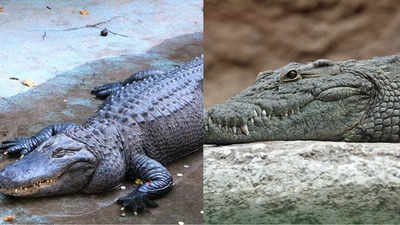
Alligators and crocodiles are both members of the order Crocodylia, a classification that groups large, semi-aquatic reptiles based on shared physical characteristics and evolutionary lineage. Within this order, there are three primary families: Alligatoridae (which includes alligators), Crocodylidae (crocodiles), and Gavialidae (gharias). This classification reflects both their similarities and important distinctions in their evolutionary history.
About 80 million years ago, during the Late Cretaceous period, alligators and crocodiles branched off from a common ancestor. Since then, each has developed unique adaptations and characteristics, although both species retain similar body shapes and ecological roles. But closer inspection reveals remarkable differences in their appearance, anatomy, and preferred habitats.
Differences between alligators and crocodiles
Alligators vs crocodiles
Taxonomic family
- Alligators: Belongs to the family Alligatoridae, which groups alligators and closely related species.
- Crocodiles: Classified under the family Crocodylidae, which includes various crocodile species worldwide. These familial differences reflect their unique evolutionary paths within the order Crocodylia, despite sharing a distant common ancestor.
Nose shape
- Alligators: Have a wide, U-shaped and rounded snout. This form is well suited to crushing prey such as turtles and shellfish commonly found in their habitats.
- Crocodiles: Has a longer, V-shaped and pointed nose. This snout shape is more adapted to capture fish and other prey in various environments, including saltwater regions.
Jaw structure
- Alligators: The upper jaw overlaps the lower jaw and hides the lower teeth when the mouth is closed, giving them a “cleaner” jawline.
- Crocodiles: Their lower teeth remain visible even when the mouth is closed, as they sit outside the upper jaw and fit into grooves, creating a more “toothy” appearance.
Sensory Organs (ISO)
- Allactors: Has integumentary sense organs (ISO) located primarily around the head and mouth. These sensory organs help detect pressure changes in water, useful for locating nearby prey.
- Crocodiles: Has ISOs distributed over almost every scale on the body, providing increased sensitivity to movement in the water around them, helping to detect prey further away.
Skeletal differences
- Alligators: Have relatively shorter humerus bones in the front legs and shorter femur bones in the hind legs, which affects their range of motion and possibly adapts them to their specific hunting and habitat needs.
- Crocodiles: Have longer humerus and femurs, which may contribute to their mobility and hunting methods in more varied and expansive territories.
Salt glands
- Alligators: Have salt glands, but they are underdeveloped and not efficient, limiting them to freshwater environments such as lakes and marshes.
- Crocodiles: Have well-functioning salt glands on their tongues, allowing them to expel excess salt and survive in saltwater environments, including mangroves and coastal deltas. This adaptation widens their habitat range.
Preferred habitat
- Alligators: Commonly found in freshwater environments such as lakes, marshes, and rivers, where their inefficient salt glands are less of a limitation.
- Crocodiles: Can thrive in saltwater and brackish environments, such as mangroves, swamps and coastal areas, thanks to their efficient salt glands, which allow them to live in a variety of habitats.
Global distribution
- Alligators: Mainly found in North and South America, with limited distribution compared to crocodiles.
- Crocodiles: Are spread across a wide range of regions, including the Americas, Africa, Asia and Australia, due to their adaptable habitat needs and wider tolerance of saltwater environments.
Evolutionary divergence
- Both: The ancestors of alligators and crocodiles diverged about 80 million years ago during the Late Cretaceous period. Despite this long evolutionary separation, both have retained some common characteristics due to their similar lifestyles as semi-aquatic predators, although each family has developed specific adaptations to suit their environments and prey.
Also read | Gray wolf vs coyote: Know the key differences based on size, diet, behavior and more
